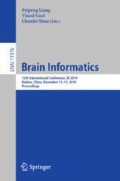Abstract
Premature infants have a significantly increased risk of developing severe neurodevelopmental disorders such as cerebral palsy and mental retardation due to some congenital defects at birth. During early infancy, distinct motion patterns occur which are highly predictive for later disability. The clinical observations of these forms of exercise can be record as parameters. In this paper, we used Kernel Correlation Filter (KCF) to track the trajectories of an infant’s limbs. Then, the obtained trajectories are analyzed in the wavelet domain and power spectrum domain, and integrated the features into the Ensemble Learning classification, the classification results are weighted and comprehensively judged to determine whether the infant’s neurodevelopment is normal and whether early intervention is needed.
Access this chapter
Tax calculation will be finalised at checkout
Purchases are for personal use only
References
Prechtl, H.F.R., Ferrari, F., Cioni, G.: Predictive value of general movements in asphyxiated fullterm infants. Early Human Dev. 35, 91–120 (1993)
Adde, L., Helbostad, J.L., Jensenius, A.R., Taraldsen, G., Grunewaldt, K.H., Stoen, R.: Early prediction of cerebral palsy by computer-based video analysis of general movements: a feasibility study. Dev. Med. Child Neurol. 52, 773–778 (2010)
Meinecke, L., Breitbach-Faller, N., Bartz, C., Damen, R., Rau, G., Disselhorst-Klug, C.: Movement analysis in the early detection of newborns at risk for developing spasticity due to infantile cerebral palsy. Hum. Mov. Sci. 25, 125–144 (2005)
Adu, J., Gan, J., Wang, Y., Huang, J.: Image fusion based on nonsubsampled contourlet transform for infrared and visible light image. Infrared Phys. Technol. 61, 94–100 (2013)
Henriques, J., Caseiro, R., Martins, P., Batista, J.: High-speed tracking with kernelized correlation filters. IEEE Trans. Pattern Anal. Mach. Intell. 37, 583–596 (2015)
Rahmati, H., Martens, H., Aamo, O., Stavdahl, Ø., Støen, R., Adde, L.: Frequency analysis and feature reduction method for prediction of cerebral palsy in young infants. IEEE Trans. Neural Syst. Rehabil. Eng. 24, 1225–1234 (2016)
Adde, L., Helbostad, J.L., Jensenius, A.R., Taraldsen, G., Støen, R.: Using computer-based video analysis in the study of fidgety movements. Early Human Dev. 85, 541–547 (2009)
Fjørtoft, T., Einspieler, C., Adde, L., Strand, L.I.: Inter-observer reliability of the “Assessment of Motor Repertoire—3 to 5 Months” based on video recordings of infants. Early Human Dev. 85, 297–302 (2009)
Adde, L., et al.: Early motor repertoire in very low birth weight infants in India is associated with motor development at one year. Eur. J. Paediatr. Neurol. 20, 918–924 (2016)
Valle, S.C., Støen, R., Sæther, R., Jensenius, A.R., Adde, L.: Test–retest reliability of computer-based video analysis of general movements in healthy term-born infants. Early Human Dev. 91, 555–558 (2015)
Stahl, A., Schellewald, C., Stavdahl, O., Aamo, O.M., Adde, L., Kirkerod, H.: An optical flow-based method to predict infantile cerebral palsy. IEEE Trans. Neural Syst. Rehabil. Eng. 20, 605–614 (2012)
Yue, T., Suo, J., Cao, X., Dai, Q.: Efficient method for high-quality removal of nonuniform blur in the wavelet domain. IEEE Trans. Circuits Syst. Video Technol. 27, 1869–1881 (2017)
Chai, Y., Li, H., Zhang, X.: Multifocus image fusion based on features contrast of multiscale products in nonsubsampled contourlet transform domain. Optik 123, 569–581 (2012)
Uijlings, J.R.R., van de Sande, K.E.A., Gevers, T., Smeulders, A.W.M.: Selective search for object recognition. Int. J. Comput. Vis. 104, 154–171 (2013)
Patel, M., Lal, S., Kavanagh, D., Rossiter, P.: Fatigue detection using computer vision. Int. J. Electron. Telecommun. 56, 457–461 (2010)
Kuen, J., Lim, K.M., Lee, C.P.: Self-taught learning of a deep invariant representation for visual tracking via temporal slowness principle. Pattern Recogn. 48, 2964–2982 (2015)
Lin, B., Wei, X., Junjie, Z.: Automatic recognition and classification of multi-channel microseismic waveform based on DCNN and SVM. Comput. Geosci. 123, 111–120 (2019)
Ojala, T., Pietikäinen, M., Harwood, D.: A comparative study of texture measures with classification based on featured distributions. Pattern Recogn. 29, 51–59 (1996)
Afifi, S., GholamHosseini, H., Sinha, R.: A system on chip for melanoma detection using FPGA-based SVM classifier. Microprocess. Microsyst. 65, 57–68 (2019)
Xu, J., Tang, Y.Y., Zou, B., Xu, Z., Li, L., Lu, Y.: The generalization ability of online SVM classification based on Markov sampling. IEEE Trans. Neural Netw. Learn. Syst. 26, 628–639 (2015)
Xiao, J.: SVM and KNN ensemble learning for traffic incident detection. Physica A: Stat. Mech. Appl. 517, 29–35 (2019)
NaNa, Z., Jin, Z.: Optimization of face tracking based on KCF and Camshift. Proc. Comput. Sci. 131, 158–166 (2018)
Nedjar, I., Daho, M., Settouti, N., Mahmoudi, S., Chikh, M.: RANDOM forest based classification of medical x-ray images using a genetic algorithm for feature selection. J. Mech. Med. Biol. 15, 1540025 (2013)
Fern, A., Schapire, R.: Online ensemble learning: an empirical study. Mach. Learn. 53, 71–109 (2003)
Author information
Authors and Affiliations
Corresponding author
Editor information
Editors and Affiliations
Rights and permissions
Copyright information
© 2019 Springer Nature Switzerland AG
About this paper
Cite this paper
Dai, X., Wang, S., Li, H., Yue, H., Min, J. (2019). Image-Assisted Discrimination Method for Neurodevelopmental Disorders in Infants Based on Multi-feature Fusion and Ensemble Learning. In: Liang, P., Goel, V., Shan, C. (eds) Brain Informatics. BI 2019. Lecture Notes in Computer Science(), vol 11976. Springer, Cham. https://doi.org/10.1007/978-3-030-37078-7_11
Download citation
DOI: https://doi.org/10.1007/978-3-030-37078-7_11
Published:
Publisher Name: Springer, Cham
Print ISBN: 978-3-030-37077-0
Online ISBN: 978-3-030-37078-7
eBook Packages: Computer ScienceComputer Science (R0)

